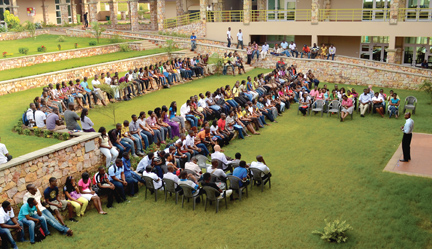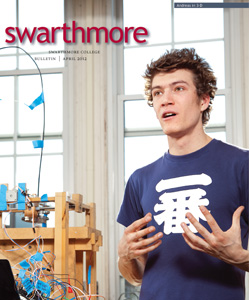Cross-Cultural Classroom Unites Ghana and Swarthmore

Patrick Awuah ’89, president of Ashesi University College, addresses first-year students in the David Cornfield & Linda Archer Cornfield Courtyard at the college in Ghana. Some members of the 650-member first-year class are enrolled in Re-Envisioning Diasporas, a new cross-continental course offered by Swarthmore and Ashesi.
Seven Swarthmore students sit in the Language Resource Center, slightly disoriented, with eyes glued to a dark screen. They listen to the sounds of a tour guide talking about African slaves in a former compound, forced to shuffle around in this darkness in chains.
This video is not a typical educational documentary. It is footage shot by the students’ fellow classmates, more than 5,000 miles away at Ashesi University College in the West African nation of Ghana.
This classroom connection—the most recent and most innovative of many exchanges between Ashesi and Swarthmore—is the product of a deep bond between the two colleges, forged when Ashesi President Patrick Awuah ’89 founded the Ghanaian institution in 2002, modeling it on his alma mater.
Re-Envisioning Diasporas, offered for the first time this spring, is adding an important new dimension to the way some Swarthmore students are learning. Cross-listed in film and media studies and literatures in translation, the class is structured so that students interact, via Skype, for 30 minutes per class meeting, with their 35 Ghanaian counterparts in an exchange of ideas about the meaning of diaspora. The course is co-taught by professors Sunka Simon and Carina Yervasi at Swarthmore and Mikelle Antoine at Ashesi. It is funded by the SUNY Center for Online International Collaborative Learning (COIL) and the Tri-Co Digital Humanities Initiative.
“We were told at the COIL Institute that the idea of 30 minutes of synchronous discussion per class was too ambitious, but that time is what makes us not two separate classes, but one,” said Yervasi, an associate professor of French.
Yervasi and Simon believe that the video of the former slave compound represents the power of the cross-cultural learning that is taking place.
“Having the guard take [the students] to a dark place and hearing this shuffling has a much more powerful effect when you hear the sound yet see nothing,” says Simon, an associate professor of German. “It forces students to ask themselves, ‘What does my voice sound like? What identity do I have?’”
The course also has had a meaningful impact on those taking it.
“A lot of the kids in Ghana consider themselves in diaspora, and an important part of thinking about diaspora is, ‘How do people in different parts of the world react to having this sort of experience?’” said Koby Levin ’15. “There are some kids here, who, if they don’t consider themselves in diaspora, have a family history of that. It’s a union of two perspectives that would never clash if we didn’t have these technologies, and we learn from that clash.”
The course has had its share of technological problems, but the participants say the institutions’ common background has made the process well worth it.
“It’s hard when a really great discussion is happening and there is something that hampers communication, like an echo,” said Mike Jones, director of the Language Resource Center and coordinator of the technological aspects of the course. “However, we are really lucky to have this institution in Ghana. They and we both have a vested interest.”
Although the form of learning has changed, the course is still deeply engrained in the ideals of the College.
“This entire course is so Swarthmore,” said Simon. “It speaks to the notion of speaking to others, providing multiple perspectives, yet also pushes the envelope. If Swarthmore is to remain Swarthmore, this [type of cross-cultural learning] has to happen.”
 Email This Page
Email This Page